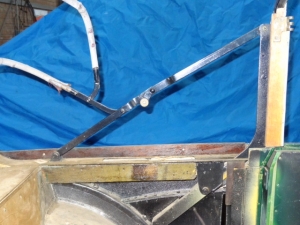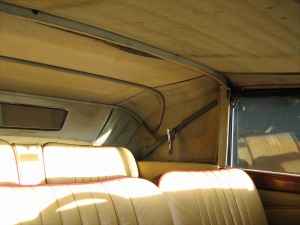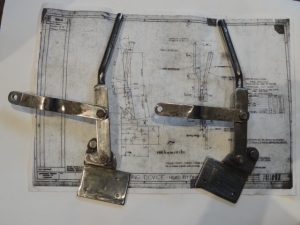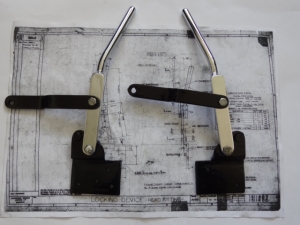Post-war 16hp / 18hp Technical Tips
Advice and guidance for the maintenance of Armstrong Siddeley cars. If you have other technical advice for Armstrong Siddeley owners you would like to share here, please contact web@siddeley.org
Please note, technical tips are given by individual members and ASOC Ltd does not warranty the accuracy of them or endorse them in any way.
More tips can be found by using the links to the right.
HURRICANE HOOD BOWS - Factory modifications to the very early cars to include a locking device - Supplied by Brian Watt, Australia
The original hood mechanism on the very early Hurricanes is rather hard to erect. The side arms, or stretchers to give them their correct title, are hinged in the centre so the hood can be folded back onto the rear of the body when fully down. To erect the hood the owner had to pull the hood forward and then force the two parts of the stretcher into a straight line before locking them in place with a chrome, knurled nut. This could be difficult as some force was required to lock the two arms of the stretcher together and they were rather awkward to get to from the front seats (See photo 1.)
 In September 1947 the factory issued a modification to the head fitting (hood bows in our language). The modification sheets are entitled: FITTING LOCKING DEVICE TO HEAD FITTING: HURRICANE COUPE. The sheets give clear instructions, with drawings, on fitting the parts to modify the hood bows and with the parts a handyman could undertake the task of retrofitting their car. The locking devices comprise a handle, a locating plate and a short lever which, when fitted, reduces significantly the effort required to straighten the stretchers and which lock them in place without the need for the knurled locking nut.
In September 1947 the factory issued a modification to the head fitting (hood bows in our language). The modification sheets are entitled: FITTING LOCKING DEVICE TO HEAD FITTING: HURRICANE COUPE. The sheets give clear instructions, with drawings, on fitting the parts to modify the hood bows and with the parts a handyman could undertake the task of retrofitting their car. The locking devices comprise a handle, a locating plate and a short lever which, when fitted, reduces significantly the effort required to straighten the stretchers and which lock them in place without the need for the knurled locking nut.

The modification was a major improvement. The parts required for this modification were made available for retrofitting existing Hurricanes and I assume all Hurricanes from this date were fitted with the modification (See photo 2.) Unfortunately my hood bows were never modified.
While the instructions are available, these are of little use to someone wanting to carry out the modification as the ASOC Stores has none of the parts and it seems they are very difficult to obtain on the second hand market.
However at this point, the fantastic resources available within the Armstrong Siddeley Owners Club come to the rescue. The factory drawings for these parts were obtained within a short space of time via the ASOC Stores and with these it was possible to recreate the locking devices.
The first thing to note is that the locking devices are handed. Also the original handle is tapered (0.5'' to 0.35''). I couldn't see any point in machining the rod and so my handles are a constant 0.5'' which made them easier to make. (See photo 3a) The job is relatively straight forward to make as the drawings are detailed. However you do need to be able to weld and shape metal. Fitting the stops is a little fiddly for example. If you can't do that a friendly metal worker can knock them up quickly.


The factory fitting instructions show how to modify the original stretchers to fit the locking device. This involves cutting and shaping the stretchers and drilling out the joining rivet. However my recommendation is to make new stretchers using pieces of 7/8'' wide flat steel. This is a very simple task requiring only a few bends and the drilling of four 5/16'' holes each side. For most people with access to a vice, a hammer and a drill it would be easier and quicker to make new stretchers than to modify the original ones. Another benefit if you make new stretchers is that a set of original ones will be available for another restorer wanting to retain his car's originality.
Some black paint and chrome plating finishes the manufacture of the parts (See photo 3b.) I recommend you assemble the mechanism using 5/16'' mushroom head bolts, brass spacing washers and dome nuts held on with Locktite rather than rivets.
Sub Menu
Login


 The
The